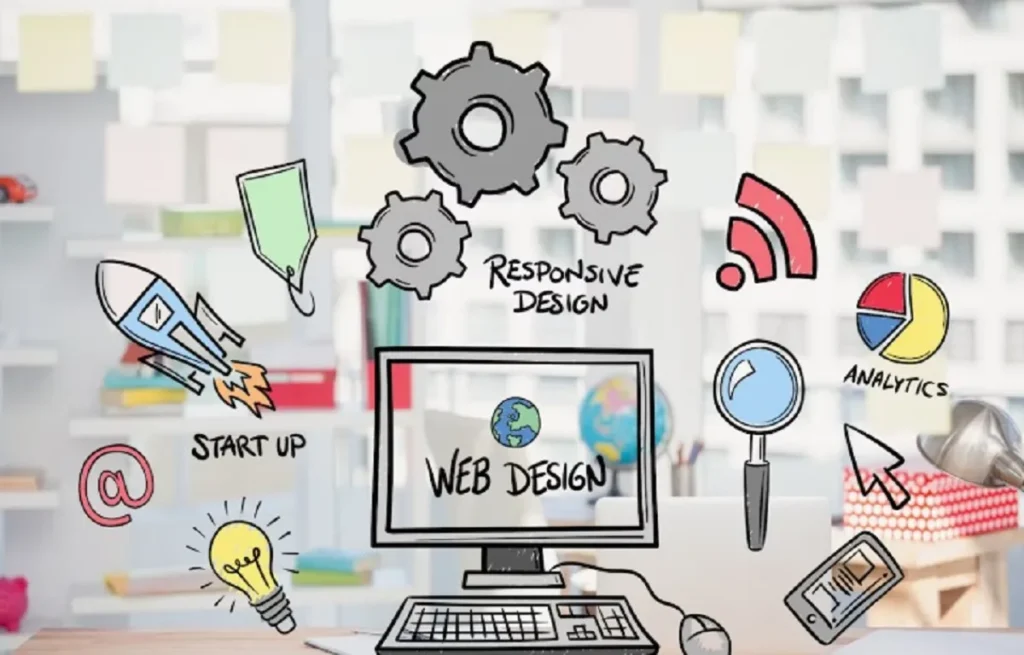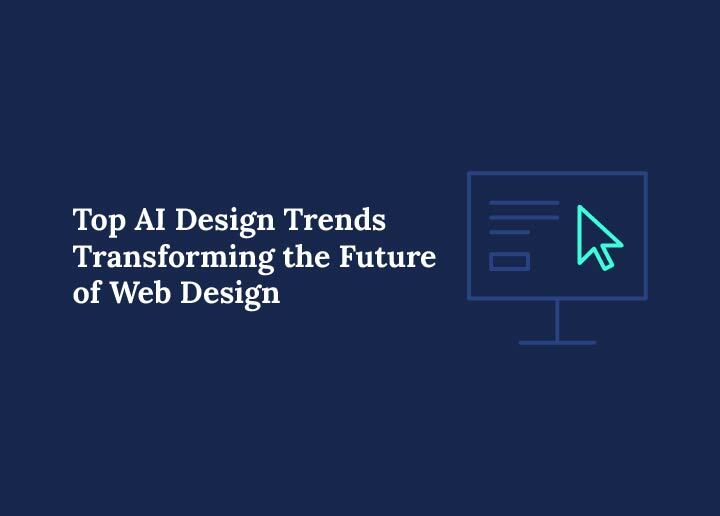In the past year, we’ve seen AI advances completely reshape the design process, making AI-powered tools an integral part of how designers create modern, aesthetically pleasing websites. From AI website builders that handle specific tasks like generating images to AI design tools for designers that help refine design systems.
These AI web design trends aren’t just “nice-to-have”, they’re essential for staying informed and competitive in the year ahead. AI features are making it faster to create and adapt design workflows, improve user engagement, and make user interactions feel more personal and intuitive.
Whether it’s using DALL·E to visualize an idea or applying data-driven insights to improve functionality, AI is becoming a helpful tool for designers, developers, and businesses looking to explore new possibilities.
As we move forward into the coming year, it’s clear that AI will not just support the design trend, it will define it. The connection between technology, designer creativity, and business goals is deepening, giving us the ability to adapt, respond, and enhance the web at a deeper level than ever before.
In this guide, we’ll explore the top trends shaping the future of web design and how to respond to them to stay ahead of the curve.
AI in Web Design: A Game-Changer
The rise of AI design tools has completely transformed the way websites are imagined, built, and maintained.
Instead of relying solely on manual work, today’s AI-powered website design solutions can speed up the entire creative process, from the initial concept to the final launch.

Designers can now use AI features to automatically generate layouts, refine color palettes, and suggest design elements that improve both form and function.
One of the biggest breakthroughs has been in UI/UX design, where AI can analyze user interactions and adapt layouts to improve user engagement.
This means websites can respond in real time to user needs, creating more personalized and intuitive experiences. For businesses, this isn’t just about looking modern, it’s about meeting customers’ expectations quickly and effectively.
AI is also redefining content generation, allowing designers and developers to instantly create relevant, high-quality text, imagery, and multimedia elements that match the site’s goals.
Moving forward, the future of AI in web design will focus on even more automation, personalization, and efficiency, helping brands create sites that are not only visually stunning but also strategically optimized for performance and growth.
Discover: Best WordPress AI Plugins to Improve Your Site
Top AI Design Trends to Watch
As AI continues playing a bigger role in the world of web design, certain trends stand out as game-changers for how designers and businesses approach creating designs.
Here are the top AI-driven innovations that are shaping the life of websites and how users experience them:
AI-Powered Website Builders
The rise of AI website builders is making it easier than ever to launch professional sites without writing code. These no-code AI tools offer intuitive drag-and-drop interfaces that let anyone bring their vision to life naturally and quickly.
Builders like Wix ADI, and 10Web are leading the charge, using AI features that guide users through the design process by generating layouts, suggesting color schemes, and even creating content automatically.
This automation not only speeds up site creation but also lets users focus on the big picture, their brand’s story and goals.
Personalized User Experiences
AI is revolutionizing how websites adjust and respond to users in real time. By analyzing behavior and engagement data, AI-driven systems tailor content and layouts dynamically, making the experience feel personal and relevant to each visitor.
This means visitors see recommendations, offers, and navigation options that fit their interests and needs, greatly improving UX optimization with AI.
As AI continues enhancing personalization, designers gain a deeper sense of connection between the site and its audience, making interactions more meaningful and effective.
AI-Generated Visuals & Branding
Visual content is key to grabbing attention, and AI is becoming an incredible partner in creating designs that stand out.
Tools like DALL·E, MidJourney, and Adobe Firefly allow designers to generate unique logos, illustrations, and custom graphics with just a few prompts. This not only speeds up the creative process but opens up new possibilities for branding that feel fresh and innovative.
These AI features give designers new ideas and help translate a brand’s vision into visuals that resonate deeply with users.
Voice-Activated & Conversational Interfaces
With AI-powered chatbots and voice search becoming commonplace, websites are adapting to a more natural way for users to interact.
Voice UI is changing how navigation is designed and how content is presented, requiring designers to think beyond clicks and scrolls. Conversational AI interfaces create smoother experiences that feel intuitive and personal, making it easier for users to find what they need.
This trend is all about enhancing the user’s journey by adding layers of interaction that make sites more accessible and responsive.
AI for Accessibility
AI tools are playing a vital role in making websites more inclusive. Features like automatic alt text generation, contrast checking, and keyboard navigation support help designers adjust sites to meet accessibility standards effortlessly.
This AI feature not only improves the experience for people with disabilities but also ensures that websites reach a broader audience.
By integrating web accessibility AI tools, designers show commitment to inclusivity while streamlining the compliance process.
Predictive Design & Automation
One of the most exciting trends is AI’s ability to predict user actions and automate testing to optimize conversions.
By using data and machine learning, AI can suggest layout changes, tweak call-to-action buttons, and even run automated A/B testing, all aimed at making the site perform better.
This kind of predictive UX lets businesses respond quickly to real user behavior, continuously enhancing their sites without constant manual adjustments. It’s a smart, data-driven way to keep websites effective and user-friendly over time.
Bring AI-Powered Design to Your Website
Get in touch with Seahawk Media today and let’s build a future-proof digital experience for your business.
How AI is Impacting Web Design Jobs?
The rise of AI is reshaping web design careers in a big way. Instead of spending hours on manual coding and repetitive tasks, web designers and developers are now shifting their focus toward higher-level strategy and creative direction.

AI-powered tools can handle much of the technical work , from generating layouts to optimizing content, freeing up professionals to concentrate on crafting unique user experiences and solving complex design challenges.
This shift means the future of web design jobs is less about writing every line of code and more about understanding user psychology, brand storytelling, and guiding AI tools effectively.
The blend of human creativity with AI assistance is opening new possibilities, making AI web development a collaborative process rather than a replacement.
For those willing to adapt, AI offers opportunities to focus on innovation and deliver smarter, more impactful websites.
Challenges & Considerations
While AI brings exciting possibilities, there are important AI design challenges to keep in mind. Over-reliance on AI can risk diluting originality, leading to websites that feel generic or formulaic.
Designers must balance automation with their own creative input to maintain uniqueness and emotional connection.
There are also ethical questions around AI ethics in web design. Issues like AI bias, where algorithms unintentionally favor certain groups or ideas, can affect inclusivity and fairness.
Plus, the heavy use of AI-generated content raises concerns about authorship and authenticity. These limitations highlight the need for thoughtful use of AI, ensuring it supports rather than replaces human creativity.
In short, while AI is transforming the industry, web designers and developers should remain critical users, combining AI’s speed and efficiency with their own vision and ethical responsibility to create truly meaningful digital experiences.
How to Prepare for the AI-Driven Future of Web Design
As AI continues to transform the web design landscape, it’s essential for designers and developers to stay ahead by upskilling in AI design tools.
Learning how to use popular AI-powered platforms and plugins will help you integrate these new technologies smoothly into your workflow. This includes getting comfortable with AI features that automate repetitive tasks, generate design ideas, or optimize user experiences.
But mastering AI isn’t just about efficiency, it’s about combining that power with your own creativity and strategic thinking. The best designers will know how to balance the speed and accuracy AI provides with a personal touch that connects with users on a deeper level.
By embracing this blend, you’ll become a future-ready web design professional, able to deliver innovative and user-focused websites that stand out.
Continuously exploring new AI tools and staying updated on future web design strategies will keep you adaptable in an ever-changing digital world.
Learn More: Sustainable Web Design Trends
Conclusion
In this blog, we’ve covered some of the most exciting AI design trends shaping the future of web design, from AI-powered website builders and personalized user experiences to AI-generated visuals and predictive automation.
These innovations aren’t just buzzwords; they represent real shifts in how designers create, iterate, and deliver websites that captivate users and drive business success.
The key takeaway? AI in web design is here to stay, offering powerful tools to enhance creativity and efficiency. If you want to stay competitive and relevant, now’s the time to experiment with AI-powered web design tools, explore new possibilities, and embrace the changes ahead.
By blending technology with your unique vision, you can unlock a future where design is faster, smarter, and more connected than ever before.
FAQs About AI Design Trends
What are the top AI design trends shaping web design today?
Some of the biggest AI design trends include AI-powered website builders with drag-and-drop interfaces, AI-driven personalized user experiences, AI-generated visuals like logos and graphics, voice-activated conversational interfaces, AI tools improving accessibility, and predictive design automation. These trends help designers create faster, smarter, and more user-friendly websites.
Are AI-generated visuals and branding effective for businesses?
Absolutely. AI tools like DALL·E and MidJourney can create unique logos, illustrations, and graphics quickly, providing fresh creative ideas that match a brand’s vision.
This helps businesses stand out with custom visuals that are both eye-catching and on-brand without spending hours on manual design.
How is AI changing the role of web designers and developers?
AI is automating repetitive coding and design tasks, allowing web designers and developers to focus more on strategy, creativity, and user-centric design.
This means professionals can spend more time on high-level planning, brand storytelling, and integrating AI tools effectively to deliver better websites.
What are some challenges of using AI in web design?
While AI offers many benefits, there are challenges like the risk of creating generic designs if overused, concerns about originality and creativity, and ethical issues like AI bias.
It’s important for designers to balance AI automation with their own creative input to maintain uniqueness and ensure inclusive, fair web experiences.
Can AI improve user experience on websites?
Yes! AI can analyze visitor behavior and dynamically adjust content, layouts, and recommendations to create personalized user experiences.
This improves engagement by showing visitors content and offers tailored to their interests, which can lead to higher satisfaction and conversions.
How do AI website builders work and why are they popular?
AI website builders use machine learning algorithms to automatically generate website layouts, color schemes, and even content based on your inputs and preferences.
They often feature simple drag-and-drop interfaces and require no coding skills. Popular tools like Wix ADI and Bookmark are popular because they help users launch professional-looking sites quickly and easily.



